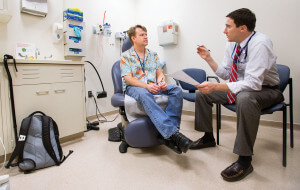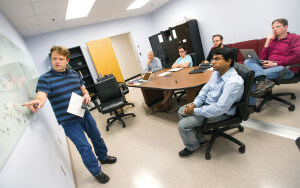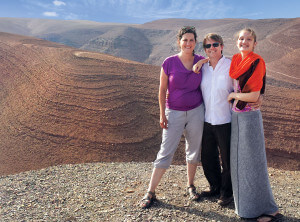- February 06, 2014
- By Lauren Brown
At first, physicist Bill Dorland blamed the discomfort in his lower back on a bad trip down the Tiny Timbers ride at Hersheypark.
Now the executive director of Maryland’s Honors College, Dorland rode a figurative roller coaster for another five years as other symptoms piled up, everything from difficulty using the bathroom to searing pain when driving long distances.
Finally, in July 2004, he was getting an MRI when the technician, glancing at the screen, asked offhandedly how long he’d been following “this.” Dorland peered over, trying not to betray his panic, and asked if the bright blob was his liver.
“No,” she said. “That’s your tumor.”
This summer marks a decade since Dorland was diagnosed with chordoma, a rare and incurable form of cancer that typically kills its victims in seven to 10 years. In other words, Dorland, now 48, isn’t supposed to be alive today.
But he decided back then to proceed matter-of-factly like the scientist he is. Inquiry. Research. Analysis of data. His conclusion: He would keep living the life he already had.

Now, he’s undergoing a clinical trial that has remarkably shrunk his most recent two tumors. The tradeoff: an inexplicable, devastating case of neuropathy in his feet that has forced him to start relying on a cane.
And while he’s mostly kept quiet about a decade of real-life drama, he volunteered to teach the opening class of a new “Deconstructing ‘Breaking Bad’” honors course by sharing his story with students. While a rotating cast of faculty led discussions such as whether entrepreneurship is always good, or the economics of the drug trade, Dorland’s topic was how a universal health care system could have changed the TV series.
“As a meditation on whether we can control our lives to any extent, it’s a fantastic show,” he says later. “In season 4, episode three or four, Walt says to another cancer patient who’s worried about being tossed in the wind, Bull****, everybody dies. You get to decide how you live.”
Star of Something New
From the start, Dorland was an independent thinker, an overachieving crusader. He and his mother moved in their trailer 16 times by the time they settled in rural Arkansas when he was in fourth grade. His dad, he says easily, is a nudist who lives off the grid with llamas outside his trailer, and raccoons and ducks cavorting around inside. His parents married more than a dozen times, and he has had more step- and half-siblings than he can count. As a result of all that, he read a lot and learned to make friends fast.
He spent a high school summer in Japan, so he was surprised upon his arrival at the University of Texas, with an enrollment of 51,000, that only eight students a year were studying abroad for credit through the institution. He and a friend mounted a campaign to expand scholarship funding to encourage UT students to study overseas and international students to come to Texas. The new student fee ultimately passed the state legislature (a year after Dorland graduated as UT’s top male student) and spread to the entire Texas university system.
His appetite for public service whetted, he told Princeton University that he would only pursue his doctorate in astrophysics there if he could simultaneously earn a master’s in public administration. He finished both in five years.
 Dorland focused his research on turbulent, magnetized plasmas, which means he tries to predict the properties of matter when it gets heated to temperatures of 100 million degrees. During an internship on nuclear policy at the U.S. Department of State, he got interested in the International Thermonuclear Experimental Reactor (ITER) project, designed to generate power on a huge scale. Later, through computer modeling, he and three colleagues at Texas and Princeton discovered flaws in the engineering design, the equivalent of throwing a Molotov cocktail into the nuclear fusion community.
Dorland focused his research on turbulent, magnetized plasmas, which means he tries to predict the properties of matter when it gets heated to temperatures of 100 million degrees. During an internship on nuclear policy at the U.S. Department of State, he got interested in the International Thermonuclear Experimental Reactor (ITER) project, designed to generate power on a huge scale. Later, through computer modeling, he and three colleagues at Texas and Princeton discovered flaws in the engineering design, the equivalent of throwing a Molotov cocktail into the nuclear fusion community.
Their findings, which appeared first in Science, reached a broad public in the New York Timesin December 1996. The National Academy of Sciences called for a review, and the U.S. ultimately pulled out of the $10 billion project.
Dorland joined Maryland’s faculty in 2001. Professor Jordan Goodman, then-chair of the physics department, hired him as a full-time faculty member a few years later. He wasn’t looking to hire anyone in Dorland’s specialty field, but, he recalls, “We saw Bill, and we said, This guy is sensational. Crap, we have no choice but to hire him.”
The Department of Energy honored Dorland in 2009 for the body of research that began with ITER. By that time, he needed the cash prize that came with the award.
CRITICAL MASS
Dorland’s resume was irrelevant to doctors. When in the late 1990s he began suffering from constipation, doctors told him to change his diet and get more rest. His daughter, Kendall, was born in 1997, and doctors attributed his pain to lifting her improperly.

“As a physicist who knows about force and levers, I was pretty annoyed,” he says.
The MRI in 2004 changed all that. By the end of the day he was at Johns Hopkins Hospital, where a nurse took Dorland’s scans to Dr. Ziya Gokaslan, vice chairman of neurosurgery. The nurse popped back 10 minutes later with the news that Dorland had chordoma.
Dorland, ever the optimist, recalls his relief at finally having an authoritative diagnosis—but it was a bleak one. Only one person in 2 million has chordoma, a form of cancer that occurs along the spine. There is no cure—after treatment, more tumors just grow back.
Gokaslan, the nation’s foremost expert on this disease, said Dorland’s tumor, along with four vertebrae and his coccyx, needed to be removed right away. He asked for four weeks to assemble the seven-surgeon team—and for $50,000 up front to pay for the operation, which Dorland’s health insurer had deemed “experimental.”
(Dorland can’t help but feel a connection to “Breaking Bad’s” antihero, Walter White, who transformed from mild chemistry teacher to drug kingpin after being diagnosed with terminal cancer that required a costly surgery.)
Dorland quickly sought a second opinion, and a loan—he and his wife, Sarah Penniston-Dorland, now an associate professor of geology at Maryland, could scrape together only $15,000 on such short notice. An aunt said not to worry, that a distant family member he’d never met could take care of the rest. He soon discovered via online sleuthing that this man was defending himself against multiple federal criminal charges.
Maybe, he wondered, he should refuse a loan from such a person. But maybe such principled stances aren’t for people whose lives are at stake.
The man generously sent all $50,000, which the Dorlands later repaid.
Carry On
The surgery was a success, though definitions of “success” with cancer tend to change. While the rest of us might mind having a three-inch scar on our chin caused by lying facedown for a 12-hour operation, Dorland brushed it off as a “dimple.” Simultaneous vomiting and fainting as he stood for the first time post-op? Sarah can smile about that now. Permanent incontinence, however, was not so easily dismissed.
Thus, Dorland’s famous backpack. As head of the Honors College, home to 4,200 of the university’s brightest undergraduates, Dorland is an administrator as well as a faculty member, mentor and researcher. He’s a big shot. But he often wears Hawaiian shirts or tees and loose-fitting khakis instead of a suit, and he always carries a black Under Armour backpack rather than a briefcase.
 The common explanation on campus is that Dorland is exceptionally approachable. That’s true. It’s also true that he requires urinary catheters, colostomy supplies and more. The “accoutrements,” as he calls them, fill the backpack.
The common explanation on campus is that Dorland is exceptionally approachable. That’s true. It’s also true that he requires urinary catheters, colostomy supplies and more. The “accoutrements,” as he calls them, fill the backpack.
“A backpack blends right in on a college campus,” he says. “I do put my laptop in there so people can think it’s just for work.”
His uncertain future also made him much more reflective. Go to Disney World? Get a new car? he recalls half-jokingly.
“I had every excuse to live large,” he says. “But I was happy with my life, and I didn’t want to change anything.”
The exception: A close Maryland colleague suggested that without mobility and continence, Dorland would belong in a nursing home. Dorland then promised himself this: He would from that point on work closely only with people he likes. Which he does. But it made him reticent to talk about his struggles or miss work. Through seven surgeries and treatments over the years, Dorland estimates he’s taken off a total of six weeks.
At Honors, which he’s led since 2008, he’s barreled ahead, launching four additional living and learning programs, doubling the size of the faculty, adding dozens of creative new classes, and cultivating a culture of intellectual engagement as well as a stronger sense of community. Meanwhile, he’s published another 35 physics papers, supervised scores of Honors 100 courses, and advised several doctoral students at Maryland and Oxford University, where he’s a visiting professor.
“At the end of a long day, Bill is still sitting at a table with his graduate students,” says Cathy Barks, associate director of the Honors College. “He always puts a good face on what must be incredibly painful, physically and emotionally.
“The way Bill copes makes it much easier for the rest of us to cope. It’s an incredible gift.”
Into Unknown Territory
Dorland hates references to people “fighting” cancer because, he says, that implies that succumbing to the disease means they didn’t fight hard enough. Nobody can accuse him of that.
An MRI in 2005 found several more tumors, and another surgery followed, to remove them and rearrange his gastrointestinal tract. The following year, he underwent a bombardment of high-dose radiation therapy at Massachusetts General Hospital, commuting back and forth to his Catonsville, Md., home and campus, and to conferences around the country.
Dorland, whose career is based on quantifying uncertainty, had to learn to live with total uncertainty. He managed the disease for a few years, with another golf ball-size tumor taken out in 2009. Sarah compared the scars on his backside to a right-lateral slip fault. Geologist humor.

But in 2012 two new tumors were deemed inoperable because of their hard-to-reach positions around his spine. Worse, they couldn’t be irradiated, because he’d previously received the maximum amount permitted.
“This is where we were getting really worried,” Sarah says. “Nobody wanted to treat them.”
He, Sarah and Kendall started family medical crisis counseling sessions. He wrote the 36 students running Honors 100 classes with him to reveal for the first time he had cancer.
The physics department took up a collection for his expenses in New York. His students made him a card that portrayed him as Superman. Hundreds of Honors students participated in a 5K run to fund research for rare diseases. These gestures lifted his spirits immeasurably.
“At every moment,” he says, “someone was there for me.”
That November, Dorland became only the fourth person to enroll in an experimental trial at Hopkins using injections of bacteria in hopes that they would start fighting the tumors (“sort of like ‘War of the Worlds’ crossed with ‘Alien,’” he told Facebook friends). In March 2013, at Memorial Sloan-Kettering Cancer Center in New York City, he was the ninth person to undergo six rounds of a super-targeted radiation treatment that relied on “temporary organ displacement.” In other words, before a beam delivered high-dose radiation to the tumors, doctors moved nearby organs out of the way to ensure they didn’t get zapped, too.
The radiation still wrecked his digestive system, though, and he was hospitalized for another week last May.
Dorland is now in a third clinical trial, this one for patients with all kinds of cancers, at the National Institutes of Health Clinical Center in Bethesda, Md., again getting immune therapy injections. His tumors have shrunk a remarkable 30 percent, says Dr. Christopher Heery, the National Cancer Institute staff clinician who is running the study. (By volume, the tumors are only one-third of their largest size.) Dorland is the only person with such results.
It’s raised the question of whether the combination of radiation and the cancer vaccine might be the answer. Heery and the Chordoma Foundation, which Dorland helped launch (see sidebar, below), are starting to plan a new trial that mimics his radiation-immunotherapy pairing.
“The amount of tumor shrinkage is impressive—whether it was from the vaccine or not,” Heery says. “It would be unusual for this to happen with radiation alone.”
Meanwhile, Dorland, Sarah and Kendall went to Morocco last summer, after he taught at Oxford again. Kendall is about to go off to college. The empty nesters are thinking of moving closer to campus and considering an apartment with an elevator for Bill.
The excruciating pain in his heels, a side effect of who-knows-which treatment, prompted doctors to approve handicapped parking for him. It took him two more months, and two falls on campus, to acknowledge he needed it, and the cane. Now he’s fending off recommendations that he consider a wheelchair.
Instead, Dorland keeps walking, gingerly. In the “Breaking Bad” class, he’s the first one up to get the lights whenever it’s time to show a clip. And when the class ends, he still smiles as he talks to students, his backpack slung over his arm. TERP
